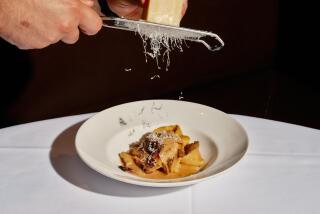Get No Kick Out of Wine? Try Champagne
If making wine seems a tricky process, consider home champagne making. “It’s like making wine about 2 1/2 times over,” says Al Fuller of Fallbrook.
Fuller was an amateur winemaker for many years, most of them devoted to champagne. He even refrigerated part of his garage for his operation.
Champagne is fermented the second time in its individual bottle, where spent yeast cells remain after sugar has been converted into alcohol and carbon dioxide. “Disgorging” the cells without losing effervescence is a painstaking process for the amateur without sophisticated equipment.
The hobbyist begins by tilting bottles sealed with caps so the necks are at 45-degree angles. Then, for several weeks, “riddling” takes place.
“You shake and twist the bottles every day, making them a little more vertical each time,” Fuller said. “Finally, they are upside-down with all the sediment at the back of the cap.”
A liquid solution made with dry ice is prepared in a pan. It is colder than the temperature at which water freezes. The champagne bottles are inverted in the solution, with the first 2 inches of the neck covered. The plug of sediment is frozen in a few minutes.
As the bottles are removed one at a time and the cap is pulled off, the ice plug with the sediment in it is blown out by pressure in the bottle. Volume is replaced with “dosage,” a combination of brandy and wine to which sugar is added if a sweeter champagne is desired.
Then a wire champagne cork is put in the bottle. The colder the room temperature during this process, the fewer the bubbles that dissolve. That’s one reason Fuller refrigerated part of his garage.
“I liked it--the challenge of an amateur doing something truly sophisticated,” he said of his former hobby.
Why did he quit?
“I like to drink it better than make it,” he said with a laugh. “Actually, I had a lot of fun with it. I just got busy with other things. But I’d tell people to have a go at it--you’ll get a kick out of it.”
More to Read
Eat your way across L.A.
Get our weekly Tasting Notes newsletter for reviews, news and more.
You may occasionally receive promotional content from the Los Angeles Times.










